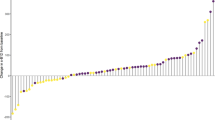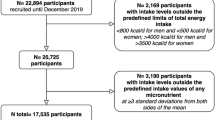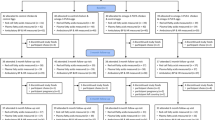Abstract
Purpose
Most children do not meet dietary guidelines for fish intake. Fish is the main source of EPA (20:5n-3), DHA (22:6n-3) and vitamin D, but may replace better iron sources such as meat. We investigated if intake of 300 g/week oily fish was achievable in children and how it affected their nutrient status. Additionally, we validated a fish food frequency questionnaire (FFQ) by correlations against EPA + DHA in red blood cells (RBC).
Methods
In a randomised 12-week trial, 199 children (8–9 years) received oily fish or poultry (control) to be eaten five times/week. We measured dietary intake and analysed fasting RBC EPA + DHA, serum 25-hydroxyvitamin D (25(OH)D), blood haemoglobin and plasma ferritin.
Results
197 (99%) children completed the study. The median (25th–75th percentile) intake was 375 (325–426) and 400 (359–452) g/week oily fish and poultry, respectively. The fish group increased their intake of EPA + DHA by 749 (593–891) mg/day and vitamin D by 3.1 (1.6–3.8) µg/day. Endpoint RBC EPA + DHA was 2.3 (95% CI 1.9; 2.6) fatty acid %-point higher than the poultry group (P < 0.001). The fish group avoided the expected 25(OH)D winter decline (P < 0.001) and had 23%-point less vitamin D insufficiency (winter subgroup, n = 82). Haemoglobin and ferritin decreased slightly in both groups (P < 0.05), but the number of children with low values did not change (P > 0.14). FFQ estimates moderately reflected habitual intake (r = 0.28–0.35) and sufficiently captured intervention-introduced changes in intake (r > 0.65).
Conclusion
Oily fish intake of 300 g/week was achievable and improved children’s EPA + DHA and 25(OH)D status, without markedly compromising iron status. These results justify public health initiatives focusing on children’s fish intake.

Similar content being viewed by others
Abbreviations
- CRP:
-
C-reactive protein
- DDPCB:
-
Dioxins and dioxin-like polychlorinated biphenyls
- DHA:
-
Docosahexaenoic acid (22:6n-3)
- EFSA:
-
European food safety authority
- EPA:
-
Eicosapentaenoic acid (20:5n-3)
- FA%:
-
Fatty acid w/w% of total fatty acids in red blood cells
- FFQ:
-
Food frequency questionnaire
- n-3 LCPUFA:
-
n-3 Long-chain polyunsaturated fatty acids
- RBC:
-
Red blood cells
- 25(OH)D:
-
25-Hydroxyvitamin D
References
Kris-Etherton PM, Harris WS, Appel LJ (2002) Fish consumption, fish oil, omega-3 fatty acids, and cardiovascular disease. Circulation 106:2747–2757. https://doi.org/10.1161/01.CIR.0000038493.65177.94
Nordic Council of Ministers (2014) Nordic nutrition recommendations 2012. Integrating nutrition and physical activity, 5th edn. Nordic Council of Ministers, Copenhagen, Denmark. https://doi.org/10.6027/nord2014-002
Lauritzen L, Brambilla P, Mazzocchi A et al (2016) DHA effects in brain development and function. Nutrients 8:6. https://doi.org/10.3390/nu8010006
Delgado-Lista J, Perez-Martinez P, Lopez-Miranda J et al (2012) Long chain omega-3 fatty acids and cardiovascular disease: a systematic review. Br J Nutr 107:S201–S213. https://doi.org/10.1017/S0007114512001596
Braegger C, Campoy C, Colomb V et al (2013) Vitamin d in the healthy European paediatric population. J Pediatr Gastroenterol Nutr 56:692–701. https://doi.org/10.1097/MPG.0b013e31828f3c05
Martineau AR, Jolliffe DA, Hooper RL et al (2017) Vitamin D supplementation to prevent acute respiratory tract infections: systematic review and meta-analysis of individual participant data. BMJ 356:i6583. https://doi.org/10.1136/bmj.i6583
Petersen RA, Dalskov S-M, Sørensen LB et al (2015) Vitamin D status is associated with cardiometabolic markers in 8–11-year-old children, independently of body fat and physical activity. Br J Nutr 114:1647–1655. https://doi.org/10.1017/S0007114515003372
Sørensen LB, Damsgaard CT, Dalskov SMM et al (2015) Diet-induced changes in iron and n-3 fatty acid status and associations with cognitive performance in 8–11-year-old Danish children: secondary analyses of the optimal well-being, development and health for Danish children through a healthy new nordic diet. Br J Nutr 114:1623–1637. https://doi.org/10.1017/s0007114515003323
Montgomery P, Burton JR, Sewell RP et al (2013) Low blood long chain omega-3 fatty acids in UK children are associated with poor cognitive performance and behavior: a cross-sectional analysis from the DOLAB study. PLoS One 8:e66697. https://doi.org/10.1371/journal.pone.0066697
Wolters M, Schlenz H, Foraita R et al (2014) Reference values of whole-blood fatty acids by age and sex from European children aged 3–8 years. Int J Obes 38:S86–S98. https://doi.org/10.1038/ijo.2014.139
Cashman KD, Dowling KG (2016) Vitamin D deficiency in Europe: pandemic? Am J Clin Nutr 103:1033–1044. https://doi.org/10.3945/ajcn.115.120873.am
Andersen R, Mølgaard C, Skovgaard LT et al (2005) Teenage girls and elderly women living in northern Europe have low winter vitamin D status. Eur J Clin Nutr 59:533–541. https://doi.org/10.1038/sj.ejcn.1602108
EFSA Panel on Dietetic Products Nutrition and Allergies (NDA) (2013) Scientific opinion on nutrient requirements and dietary intakes of infants and young children in the European Union. Parma, Italy. https://doi.org/10.2903/j.efsa.2013.3408
Pedersen AN, Christensen T, Matthiessen J et al (2015) Danskernes kostvaner 2011–2013. Hovedresultater (Dietary habits in Denmark 2011–2013. Main results), 1st edn. National Food Institute, Technical University of Denmark, Søborg
Public Health England (2016) The eatwell guide—helping you eat a healthy, balanced diet. GOV.UK. https://www.gov.uk/government/publications/the-eatwell-guide. Accessed 06 Aug 2018
U.S. Department of Health and Human Services and U.S. Department of Agriculture (2015). 2015–2020 Dietary Guidelines for Americans, 8th edition. Office of Disease Prevention and Health Promotion. https://health.gov/dietaryguidelines/2015/guidelines/. Accessed 06 Aug 2018
The Federal Ministry of Health (2007) Eating well with Canada’s food guide. Health Canada. https://www.canada.ca/en/health-canada/services/canada-food-guide/about/history-food-guide/eating-well-with-canada-food-guide-2007.html. Accessed 06 Aug 2018
Public Health England and Food Standards Agency (2014) National diet and nutrition survey: results from years 1–4 (combined) of the rolling programme (2008/2009–2011/2012). GOV.UK. https://www.gov.uk/government/statistics/national-diet-and-nutrition-survey-results-from-years-1-to-4-combined-of-the-rolling-programme-for-2008-and-2009-to-2011-and-2012. Accessed 06 Aug 2018
Commonwealth Scientific Industrial Research Organisation (CSIRO), Preventative Health National Research Flagship and the University of South Australia (2008) 2007 Australian national children’s nutrition and physical activity survey. Main findings. Commonwealth of Australia, Canberra
Olsen SO, Scholderer J, Brunsø K et al (2007) Exploring the relationship between convenience and fish consumption: a cross-cultural study. Appetite 49:84–91. https://doi.org/10.1016/j.appet.2006.12.002
McManus A, Burns SK, Howat PA et al (2007) Factors influencing the consumption of seafood among young children in Perth: a qualitative study. BMC Public Health 7:1–7. https://doi.org/10.1186/1471-2458-7-119
Brenna JT, Plourde M, Stark KD et al (2018) Best practices for the design, laboratory analysis, and reporting of trials involving fatty acids. Am J Clin Nutr 108:211–227
Ansari MR, Agustina R, Khusun H et al (2016) Development and evaluation of a semiquantitative food frequency questionnaire for estimating omega-3 and omega-6 fatty acid intakes in Indonesian children. Asia Pac J Clin Nutr 25:S20–S29. https://doi.org/10.6133/apjcn.122016.s4
Burrows T, Berthon B, Garg ML et al (2012) A comparative validation of a child food frequency questionnaire using red blood cell membrane fatty acids. Eur J Clin Nutr 66:825–829. https://doi.org/10.1038/ejcn.2012.26
Orton HD, Szabo NJ, Clare-Salzler M et al (2008) Comparison between omega-3 and omega-6 polyunsaturated fatty acid intakes as assessed by a food frequency questionnaire and erythrocyte membrane fatty acid composition in young children. Eur J Clin Nutr 62:733–738. https://doi.org/10.1038/sj.ejcn.1602763
Damsgaard CT, Lauritzen L, Hauger H et al (2016) Effects of oily fish intake on cardiovascular risk markers, cognitive function, and behavior in school-aged children: study protocol for a randomized controlled trial. Trials 17:510. https://doi.org/10.1186/s13063-016-1647-z
The Danish Veterinary and Food Administration (2004) Alt om Kost (everything about diet). http://www.altomkost.dk. Accessed 06 Aug 2018
MADLOG Aps (2016) MADLOG. http://www.madlog.dk. Accessed 01 July 2017
National Food Institute (The Technical University of Denmark) (2008) Fødevaredatabanken, version 7 (National food database). http://www.foodcomp.dk. Accessed 01 July 2017
Overvad K, Tjønneland A, Haraldsdóttir J et al (1991) Development of semiquantitative food frequency questionnaire to assess food, energy and nutrient intake in Denmark. Int J Epidemiol 20:900–905
Tjønneland A, Overvad K, Haraldsdóttir J et al (1991) Validation of semiquantitative food frequency questionnaire developed in Denmark. Int J Epidemiol 20:906–912
Ygil KH (2013) Mål, vægt og portionsstørrelser på fødevarer (Measures, weight and portion sizes of food), 1st edn. National Food Institute, Technical University of Denmark, Søborg
National Food Institute (2016) Fødevaredata, version 2 (National food database). The Technical University of Denmark, http://www.frida.fooddata.dk. Accessed 25 Aug 2017
Metherel AH, Buzikievich LM, Charkhzarin P et al (2012) Omega-3 polyunsaturated fatty acid profiling using fingertip-prick whole blood does not require overnight fasting before blood collection. Nutr Res 32:547–556. https://doi.org/10.1016/j.nutres.2012.06.016
Barnkob LL, Petersen PM, Nielsen JP, Jakobsen J (2019) Vitamin D enhanced pork from pigs exposed to artificial UVB light in indoor facilities. Eur Food Res Technol 245(2):411–418
Burild A, Frandsen HL, Jakobsen J (2014) Simultaneous quantification of vitamin D3, 25-hydroxyvitamin D3 and 24,25-dihydroxyvitamin D3 in human serum by LC-MS/MS. Scand J Clin Lab Invest 74(5):418–423
Ross AC, Manson JE, Abrams SA et al (2011) The 2011 Report on dietary reference intakes for calcium and vitamin D from the institute of medicine: what clinicians need to know. J Clin Endocrinol Metab 96:53–58. https://doi.org/10.1210/jc.2010-2704
World Health Organization (WHO) (2011) Haemoglobin concentrations for the diagnosis of anaemia and assessment of severity. Vitamin and Mineral Nutrition Information System, Geneva
World Health Organization (WHO) (2011) Serum ferritin concentrations for the assessment of iron status and iron deficiency in populations. Vitamin and Mineral Nutrition Information System, Geneva (WHO/NMH/NHD/MNM/11.2)
Damsgaard CT, Dalskov S-M, Laursen RP et al (2014) Provision of healthy school meals does not affect the metabolic syndrome score in 8–11-year-old children, but reduces cardiometabolic risk markers despite increasing waist circumference. Br J Nutr 112:1826–1836. https://doi.org/10.1017/S0007114514003043
EFSA Panel on Dietetic Products Nutrition and Allergies (NDA) (2010) Scientific opinion on dietary reference values for fats, including saturated fatty acids, polyunsaturated fatty acids, monounsaturated fatty acids, trans fatty acids, and cholesterol. EFSA Panel on Dietetic Products Nutrition and Allergies (NDA), Parma
Damsgaard CT, Schack-nielsen L, Michaelsen KF et al (2006) Fish oil affects blood pressure and the plasma lipid profile in healthy Danish infants. Nutr Dis 136:94–99
Pedersen MH, Molgaard C, Hellgren LI et al (2010) Effects of fish oil supplementation on markers of the metabolic syndrome. J Pediatr 157:395–400
Stark KD, Aristizabal Henao JJ, Metherel AH et al (2016) Translating plasma and whole blood fatty acid compositional data into the sum of eicosapentaenoic and docosahexaenoic acid in erythrocytes. Prostaglandins Leukot Essent Fat Acids 104:1–10. https://doi.org/10.1016/j.plefa.2015.11.002
Handeland K, Skotheim S, Baste V et al (2018) The effects of fatty fish intake on adolescents’ nutritional status and associations with attention performance: results from the FINS-TEENS randomized controlled trial. Nutr J. https://doi.org/10.1186/s12937-018-0328-z
Itomura M, Hamazaki K, Sawazaki S et al (2005) The effect of fish oil on physical aggression in schoolchildren—a randomized, double-blind, placebo-controlled trial. J Nutr Biochem 16:163–171. https://doi.org/10.1016/j.jnutbio.2004.10.009
Stark KD, Van Elswyk ME, Higgins MR et al (2016) Global survey of the omega-3 fatty acids, docosahexaenoic acid and eicosapentaenoic acid in the blood stream of healthy adults. Prog Lipid Res 63:132–152. https://doi.org/10.1016/j.plipres.2016.05.001
Øyen J, Kvestad I, Midtbø LK et al (2018) Fatty fish intake and cognitive function: FINS-KIDS, a randomized controlled trial in preschool children. BMC Med 16:1–15. https://doi.org/10.1186/s12916-018-1020-z
Petersen RA, Damsgaard CT, Dalskov S et al (2015) Effects of school meals with weekly fish servings on vitamin D status in Danish children: secondary outcomes from the OPUS (optimal well-being, development and health for Danish children through a healthy New Nordic Diet) School Meal Study. J Nutr Sci. https://doi.org/10.1017/jns.2015.15
Mejbom H, Andersen R, Bredsdorff L et al (2010) D-vitamin—Opdatering af videnskabelig evidens for sygdomsforebyggelse og anbefalinger (Vitamin D—update of scientific evidence for disease prevention and recommendations), 1st edn. National Food Institute, Technical University of Denmark, Søborg.
Lehmann U, Gjessing HR, Hirche F et al (2015) Efficacy of fish intake on vitamin D status: a meta-analysis of randomized controlled trials. Am J Clin Nutr 102:837–847. https://doi.org/10.3945/ajcn.114.105395
Demmelmair H, Øyen J, Pickert T et al (2018) The effect of Atlantic salmon consumption on the cognitive performance of preschool children—a randomized controlled trial. Clin Nutr. https://doi.org/10.1016/j.clnu.2018.11.031(Published Online First)
Stewart BW, Wild CP (2014) World Cancer Report 2014. Lyon (9283204298)
Ovesen L, Astrup A, Hansen M et al (2002) Jern - bør forsyningen i den danske befolkning forbedres? (Iron - should the supply in the Danish population be improved?). FødevareRapport, no. 2002:18
Snetselaar L, Stumbo P, Chenard C et al (2004) Adolescents Eating diets rich in either lean beef or lean poultry and fish reduced fat and saturated fat intake and those eating beef maintained serum ferritin status. J Am Diet Assoc 104:424–428. https://doi.org/10.1016/j.jada.2003.12.016
Navas-Carretero S, Pérez-Granados AM, Schoppen S et al (2009) Iron status biomarkers in iron deficient women consuming oily fish versus red meat diet. J Physiol Biochem 65:165–174
Anzman-Frasca S, Savage JS, Marini ME et al (2012) Repeated exposure and associative conditioning promote preschool children’s liking of vegetables. Appetite 58:543–553
Cooke L (2007) The importance of exposure for healthy eating in childhood: a review. J Hum Nutr Diet 20:294–301. https://doi.org/10.1111/j.1365-277X.2007.00804.x
Lucas M, Asselin G, Merette C et al (2009) Validation of an FFQ for evaluation of EPA and DHA intake. Public Health Nutr 12:1783–1790
Sun Q, Ma J, Campos H et al (2007) Comparison between plasma and erythrocyte fatty acid content as biomarkers of fatty acid intake in US women. Am J Clin Nutr 86:74–81
Sullivan BL, Williams PG, Meyer BJ (2006) Biomarker validation of a long-chain omega-3 polyunsaturated fatty acid food frequency questionnaire. Lipids 41:845–850
Patterson AC, Chalil A, Aristizabal Henao JJ et al (2015) Omega-3 polyunsaturated fatty acid blood biomarkers increase linearly in men and women after tightly controlled intakes of 0.25, 0.5, and 1 g/d of EPA + DHA. Nutr Res 35:1040–1051. https://doi.org/10.1016/j.nutres.2015.09.016
Danmarks Statistik (Statistics Denmark) (2018) Befolkningens højst fuldførte uddannelse (The population’s highest education completed). https://www.dst.dk/da/Statistik/emner/uddannelse-og-viden/befolkningens-uddannelsesstatus/befolkningens-hoejst-fuldfoerte-uddannelse. Accessed 29 Aug 2018
Sundhedsdatastyrelsen (2015) Den Nationale Børnedatabase—Tal for børns sundhed (The National Child database—Numbers on children’s health). http://www.esundhed.dk/sundhedsregistre/BDB/Sider/BDB.aspx. Accessed 29 Aug 2018
Acknowledgements
SV helped design the study, conducted the study, analysed the data, and drafted and finalised the manuscript; MNT helped design the study and conducted the study; NGB conducted the study; KS analysed the blood fatty acid content; JJ analysed serum 25(OH)D; CM designed the study; LL designed the study; CTD designed the study, analysed the data and drafted the manuscript. All the authors reviewed, provided input to and approved the final manuscript.
Funding
The FiSK study was supported by Nordea-fonden (Grant no. 02-2015-1429). Study foods were purchased from Skagenfood A/S, Sødam A/S via gaardmester.dk and REMA1000 Danmark A/S with discount, and provided in kind by Amanda Seafoods A/S.
Author information
Authors and Affiliations
Corresponding author
Ethics declarations
Conflict of interest
On behalf of all the authors, the corresponding author states that there is no conflict of interest.
Electronic supplementary material
Below is the link to the electronic supplementary material.
394_2019_1981_MOESM1_ESM.pdf
Supplementary Figure S1. Flow chart of children in the FiSK Junior study from invitation letter to study completion. (PDF 74 kb)
Rights and permissions
About this article
Cite this article
Vuholm, S., Teisen, M.N., Buch, N.G. et al. Is high oily fish intake achievable and how does it affect nutrient status in 8–9-year-old children?: the FiSK Junior trial. Eur J Nutr 59, 1205–1218 (2020). https://doi.org/10.1007/s00394-019-01981-y
Received:
Accepted:
Published:
Issue Date:
DOI: https://doi.org/10.1007/s00394-019-01981-y




